Environmental Sustainability Report: Nestle Coffee Product Analysis
VerifiedAdded on 2023/03/20
|7
|1434
|73
Report
AI Summary
This report provides a comprehensive analysis of Nestle Coffee's sustainability practices, addressing the product's environmental footprint and ethical considerations. The report begins with a personal ecological footprint assessment, followed by an examination of Nestle Coffee's production process, packaging, and energy and water consumption. It identifies causes of unsustainability, such as packaging failures, energy consumption, and excessive water usage. The report explores waste design, product design, and stakeholder expectations, including consumers, employees, and government entities. It highlights key CSR issues and offers recommendations for improving sustainability, such as adopting recyclable packaging and aligning marketing communications with consumer concerns. The analysis concludes by emphasizing the importance of reducing consumption and choosing sustainable brands to mitigate environmental impact and promote well-being.

Running head: ETHICS AND SUSTAINABILITY
ETHICS AND SUSTAINABILITY
Name of the Student
Name of the University
Author Note
ETHICS AND SUSTAINABILITY
Name of the Student
Name of the University
Author Note
Paraphrase This Document
Need a fresh take? Get an instant paraphrase of this document with our AI Paraphraser
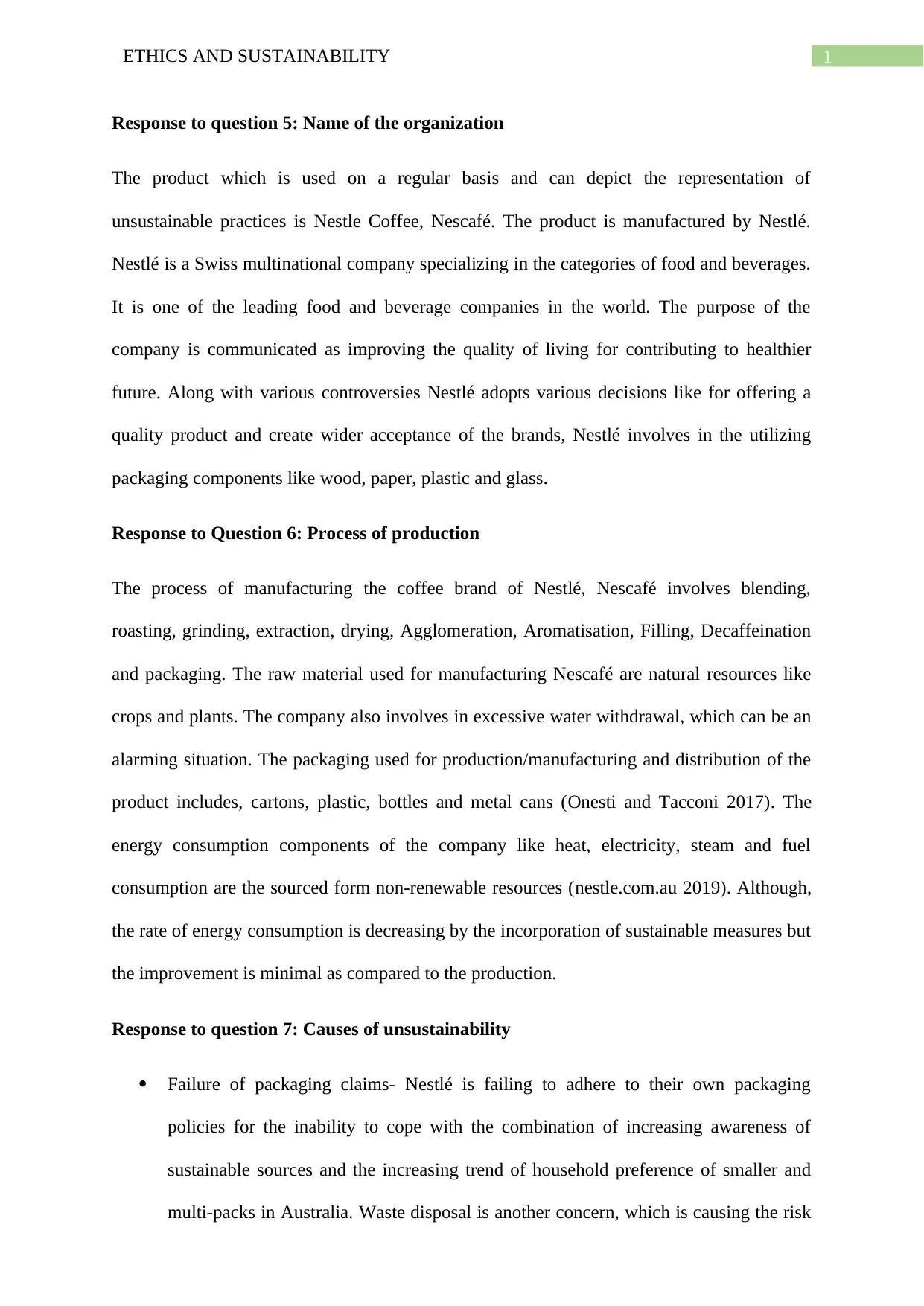
1ETHICS AND SUSTAINABILITY
Response to question 5: Name of the organization
The product which is used on a regular basis and can depict the representation of
unsustainable practices is Nestle Coffee, Nescafé. The product is manufactured by Nestlé.
Nestlé is a Swiss multinational company specializing in the categories of food and beverages.
It is one of the leading food and beverage companies in the world. The purpose of the
company is communicated as improving the quality of living for contributing to healthier
future. Along with various controversies Nestlé adopts various decisions like for offering a
quality product and create wider acceptance of the brands, Nestlé involves in the utilizing
packaging components like wood, paper, plastic and glass.
Response to Question 6: Process of production
The process of manufacturing the coffee brand of Nestlé, Nescafé involves blending,
roasting, grinding, extraction, drying, Agglomeration, Aromatisation, Filling, Decaffeination
and packaging. The raw material used for manufacturing Nescafé are natural resources like
crops and plants. The company also involves in excessive water withdrawal, which can be an
alarming situation. The packaging used for production/manufacturing and distribution of the
product includes, cartons, plastic, bottles and metal cans (Onesti and Tacconi 2017). The
energy consumption components of the company like heat, electricity, steam and fuel
consumption are the sourced form non-renewable resources (nestle.com.au 2019). Although,
the rate of energy consumption is decreasing by the incorporation of sustainable measures but
the improvement is minimal as compared to the production.
Response to question 7: Causes of unsustainability
Failure of packaging claims- Nestlé is failing to adhere to their own packaging
policies for the inability to cope with the combination of increasing awareness of
sustainable sources and the increasing trend of household preference of smaller and
multi-packs in Australia. Waste disposal is another concern, which is causing the risk
Response to question 5: Name of the organization
The product which is used on a regular basis and can depict the representation of
unsustainable practices is Nestle Coffee, Nescafé. The product is manufactured by Nestlé.
Nestlé is a Swiss multinational company specializing in the categories of food and beverages.
It is one of the leading food and beverage companies in the world. The purpose of the
company is communicated as improving the quality of living for contributing to healthier
future. Along with various controversies Nestlé adopts various decisions like for offering a
quality product and create wider acceptance of the brands, Nestlé involves in the utilizing
packaging components like wood, paper, plastic and glass.
Response to Question 6: Process of production
The process of manufacturing the coffee brand of Nestlé, Nescafé involves blending,
roasting, grinding, extraction, drying, Agglomeration, Aromatisation, Filling, Decaffeination
and packaging. The raw material used for manufacturing Nescafé are natural resources like
crops and plants. The company also involves in excessive water withdrawal, which can be an
alarming situation. The packaging used for production/manufacturing and distribution of the
product includes, cartons, plastic, bottles and metal cans (Onesti and Tacconi 2017). The
energy consumption components of the company like heat, electricity, steam and fuel
consumption are the sourced form non-renewable resources (nestle.com.au 2019). Although,
the rate of energy consumption is decreasing by the incorporation of sustainable measures but
the improvement is minimal as compared to the production.
Response to question 7: Causes of unsustainability
Failure of packaging claims- Nestlé is failing to adhere to their own packaging
policies for the inability to cope with the combination of increasing awareness of
sustainable sources and the increasing trend of household preference of smaller and
multi-packs in Australia. Waste disposal is another concern, which is causing the risk
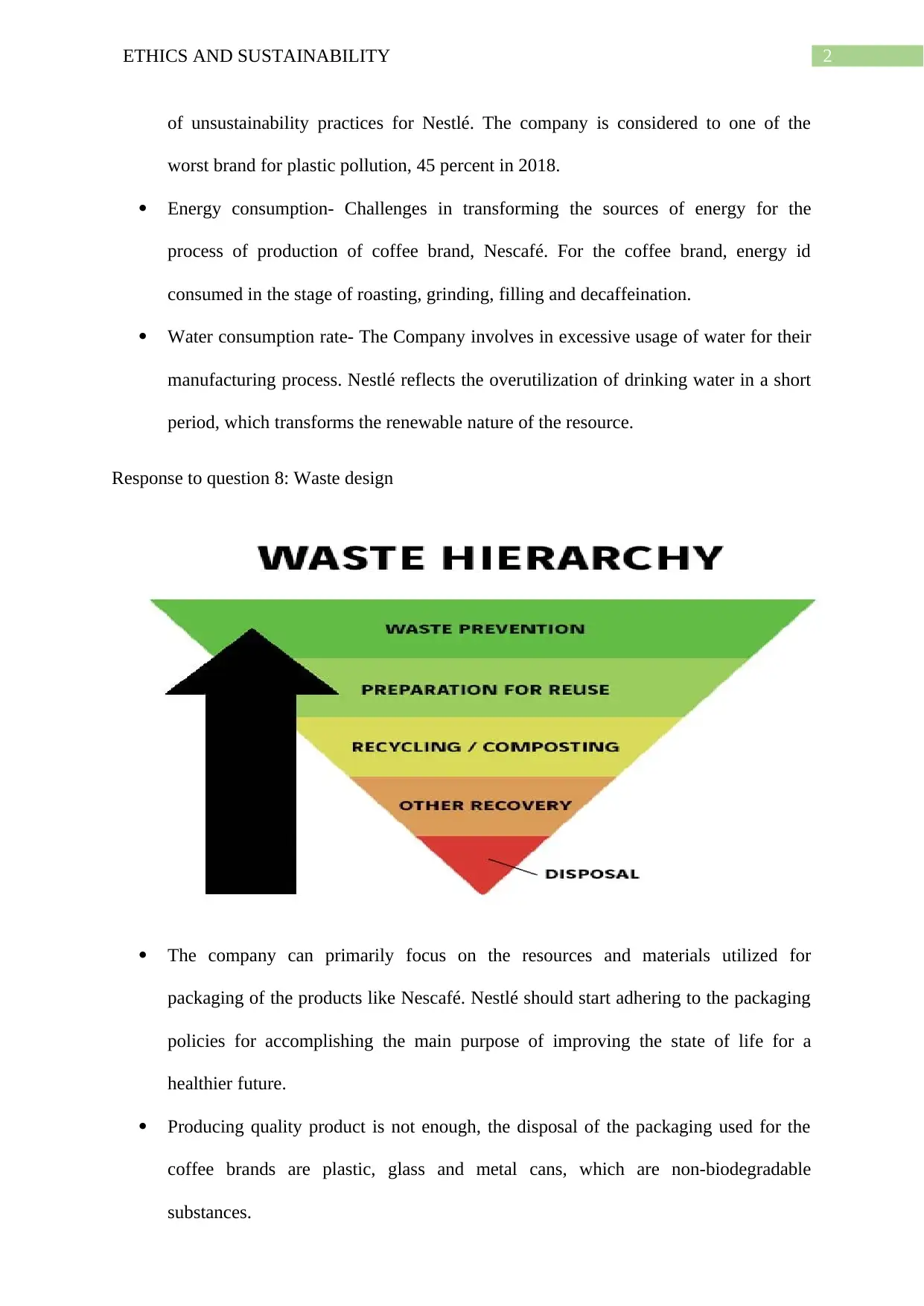
2ETHICS AND SUSTAINABILITY
of unsustainability practices for Nestlé. The company is considered to one of the
worst brand for plastic pollution, 45 percent in 2018.
Energy consumption- Challenges in transforming the sources of energy for the
process of production of coffee brand, Nescafé. For the coffee brand, energy id
consumed in the stage of roasting, grinding, filling and decaffeination.
Water consumption rate- The Company involves in excessive usage of water for their
manufacturing process. Nestlé reflects the overutilization of drinking water in a short
period, which transforms the renewable nature of the resource.
Response to question 8: Waste design
The company can primarily focus on the resources and materials utilized for
packaging of the products like Nescafé. Nestlé should start adhering to the packaging
policies for accomplishing the main purpose of improving the state of life for a
healthier future.
Producing quality product is not enough, the disposal of the packaging used for the
coffee brands are plastic, glass and metal cans, which are non-biodegradable
substances.
of unsustainability practices for Nestlé. The company is considered to one of the
worst brand for plastic pollution, 45 percent in 2018.
Energy consumption- Challenges in transforming the sources of energy for the
process of production of coffee brand, Nescafé. For the coffee brand, energy id
consumed in the stage of roasting, grinding, filling and decaffeination.
Water consumption rate- The Company involves in excessive usage of water for their
manufacturing process. Nestlé reflects the overutilization of drinking water in a short
period, which transforms the renewable nature of the resource.
Response to question 8: Waste design
The company can primarily focus on the resources and materials utilized for
packaging of the products like Nescafé. Nestlé should start adhering to the packaging
policies for accomplishing the main purpose of improving the state of life for a
healthier future.
Producing quality product is not enough, the disposal of the packaging used for the
coffee brands are plastic, glass and metal cans, which are non-biodegradable
substances.
⊘ This is a preview!⊘
Do you want full access?
Subscribe today to unlock all pages.

Trusted by 1+ million students worldwide
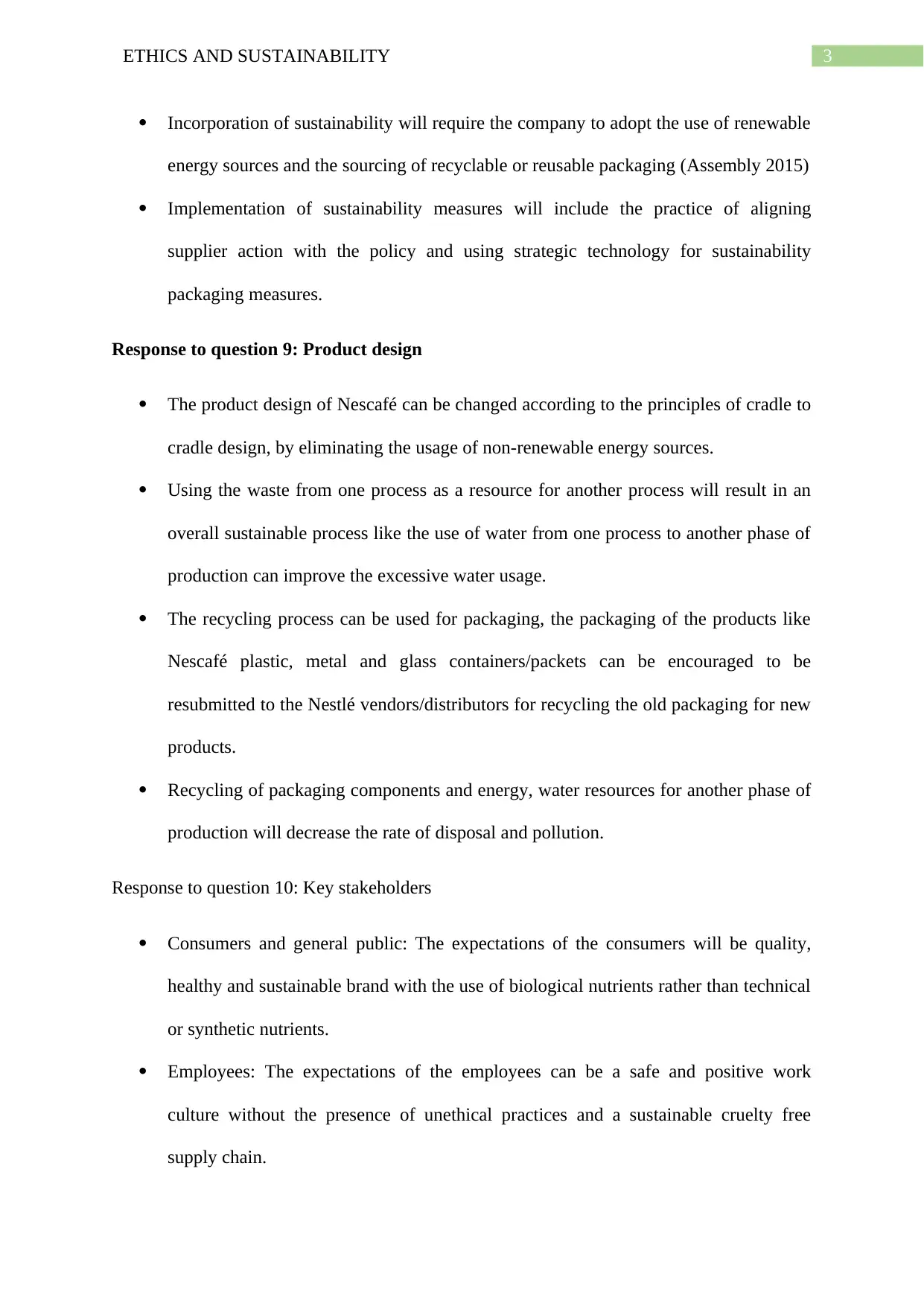
3ETHICS AND SUSTAINABILITY
Incorporation of sustainability will require the company to adopt the use of renewable
energy sources and the sourcing of recyclable or reusable packaging (Assembly 2015)
Implementation of sustainability measures will include the practice of aligning
supplier action with the policy and using strategic technology for sustainability
packaging measures.
Response to question 9: Product design
The product design of Nescafé can be changed according to the principles of cradle to
cradle design, by eliminating the usage of non-renewable energy sources.
Using the waste from one process as a resource for another process will result in an
overall sustainable process like the use of water from one process to another phase of
production can improve the excessive water usage.
The recycling process can be used for packaging, the packaging of the products like
Nescafé plastic, metal and glass containers/packets can be encouraged to be
resubmitted to the Nestlé vendors/distributors for recycling the old packaging for new
products.
Recycling of packaging components and energy, water resources for another phase of
production will decrease the rate of disposal and pollution.
Response to question 10: Key stakeholders
Consumers and general public: The expectations of the consumers will be quality,
healthy and sustainable brand with the use of biological nutrients rather than technical
or synthetic nutrients.
Employees: The expectations of the employees can be a safe and positive work
culture without the presence of unethical practices and a sustainable cruelty free
supply chain.
Incorporation of sustainability will require the company to adopt the use of renewable
energy sources and the sourcing of recyclable or reusable packaging (Assembly 2015)
Implementation of sustainability measures will include the practice of aligning
supplier action with the policy and using strategic technology for sustainability
packaging measures.
Response to question 9: Product design
The product design of Nescafé can be changed according to the principles of cradle to
cradle design, by eliminating the usage of non-renewable energy sources.
Using the waste from one process as a resource for another process will result in an
overall sustainable process like the use of water from one process to another phase of
production can improve the excessive water usage.
The recycling process can be used for packaging, the packaging of the products like
Nescafé plastic, metal and glass containers/packets can be encouraged to be
resubmitted to the Nestlé vendors/distributors for recycling the old packaging for new
products.
Recycling of packaging components and energy, water resources for another phase of
production will decrease the rate of disposal and pollution.
Response to question 10: Key stakeholders
Consumers and general public: The expectations of the consumers will be quality,
healthy and sustainable brand with the use of biological nutrients rather than technical
or synthetic nutrients.
Employees: The expectations of the employees can be a safe and positive work
culture without the presence of unethical practices and a sustainable cruelty free
supply chain.
Paraphrase This Document
Need a fresh take? Get an instant paraphrase of this document with our AI Paraphraser
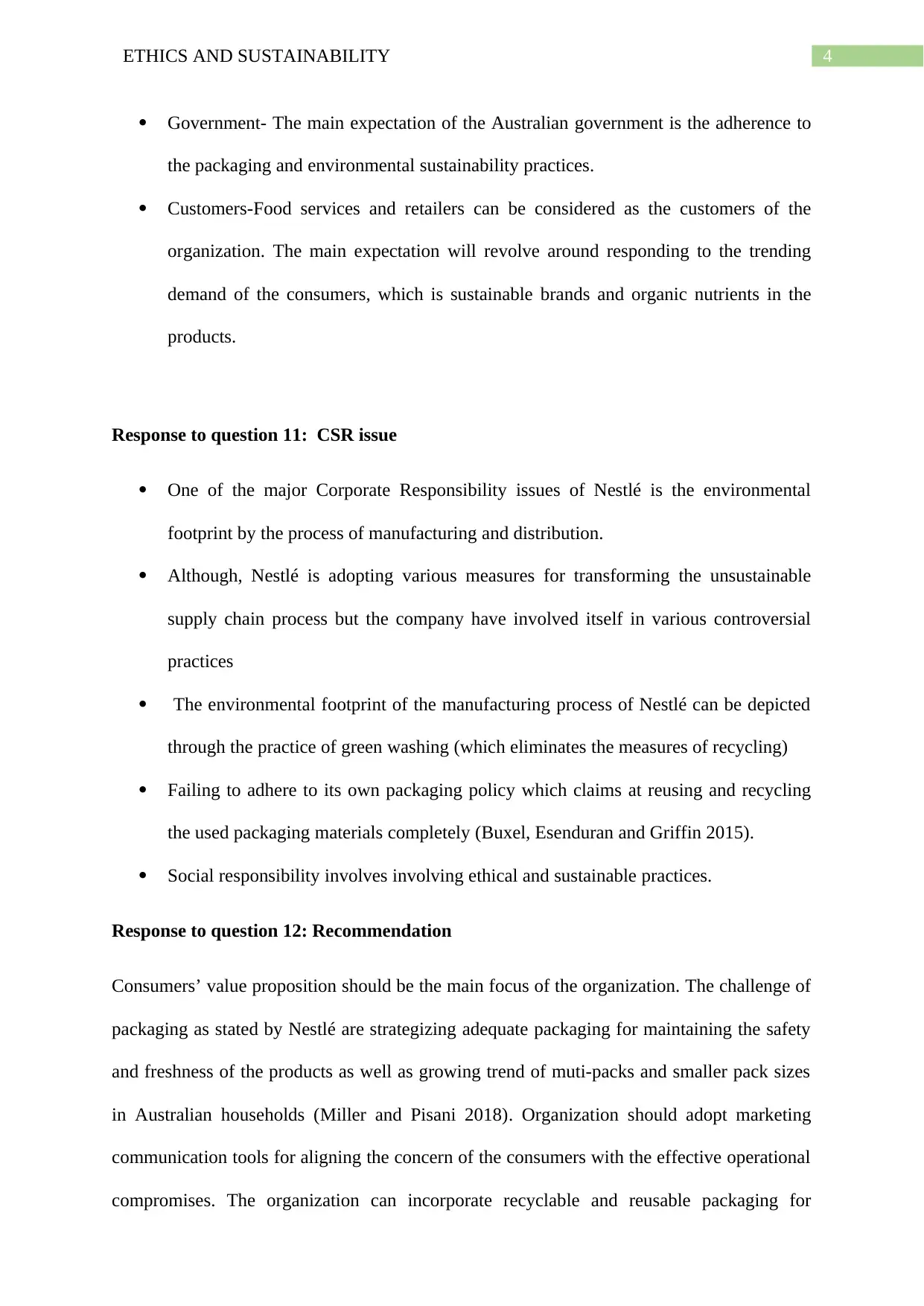
4ETHICS AND SUSTAINABILITY
Government- The main expectation of the Australian government is the adherence to
the packaging and environmental sustainability practices.
Customers-Food services and retailers can be considered as the customers of the
organization. The main expectation will revolve around responding to the trending
demand of the consumers, which is sustainable brands and organic nutrients in the
products.
Response to question 11: CSR issue
One of the major Corporate Responsibility issues of Nestlé is the environmental
footprint by the process of manufacturing and distribution.
Although, Nestlé is adopting various measures for transforming the unsustainable
supply chain process but the company have involved itself in various controversial
practices
The environmental footprint of the manufacturing process of Nestlé can be depicted
through the practice of green washing (which eliminates the measures of recycling)
Failing to adhere to its own packaging policy which claims at reusing and recycling
the used packaging materials completely (Buxel, Esenduran and Griffin 2015).
Social responsibility involves involving ethical and sustainable practices.
Response to question 12: Recommendation
Consumers’ value proposition should be the main focus of the organization. The challenge of
packaging as stated by Nestlé are strategizing adequate packaging for maintaining the safety
and freshness of the products as well as growing trend of muti-packs and smaller pack sizes
in Australian households (Miller and Pisani 2018). Organization should adopt marketing
communication tools for aligning the concern of the consumers with the effective operational
compromises. The organization can incorporate recyclable and reusable packaging for
Government- The main expectation of the Australian government is the adherence to
the packaging and environmental sustainability practices.
Customers-Food services and retailers can be considered as the customers of the
organization. The main expectation will revolve around responding to the trending
demand of the consumers, which is sustainable brands and organic nutrients in the
products.
Response to question 11: CSR issue
One of the major Corporate Responsibility issues of Nestlé is the environmental
footprint by the process of manufacturing and distribution.
Although, Nestlé is adopting various measures for transforming the unsustainable
supply chain process but the company have involved itself in various controversial
practices
The environmental footprint of the manufacturing process of Nestlé can be depicted
through the practice of green washing (which eliminates the measures of recycling)
Failing to adhere to its own packaging policy which claims at reusing and recycling
the used packaging materials completely (Buxel, Esenduran and Griffin 2015).
Social responsibility involves involving ethical and sustainable practices.
Response to question 12: Recommendation
Consumers’ value proposition should be the main focus of the organization. The challenge of
packaging as stated by Nestlé are strategizing adequate packaging for maintaining the safety
and freshness of the products as well as growing trend of muti-packs and smaller pack sizes
in Australian households (Miller and Pisani 2018). Organization should adopt marketing
communication tools for aligning the concern of the consumers with the effective operational
compromises. The organization can incorporate recyclable and reusable packaging for
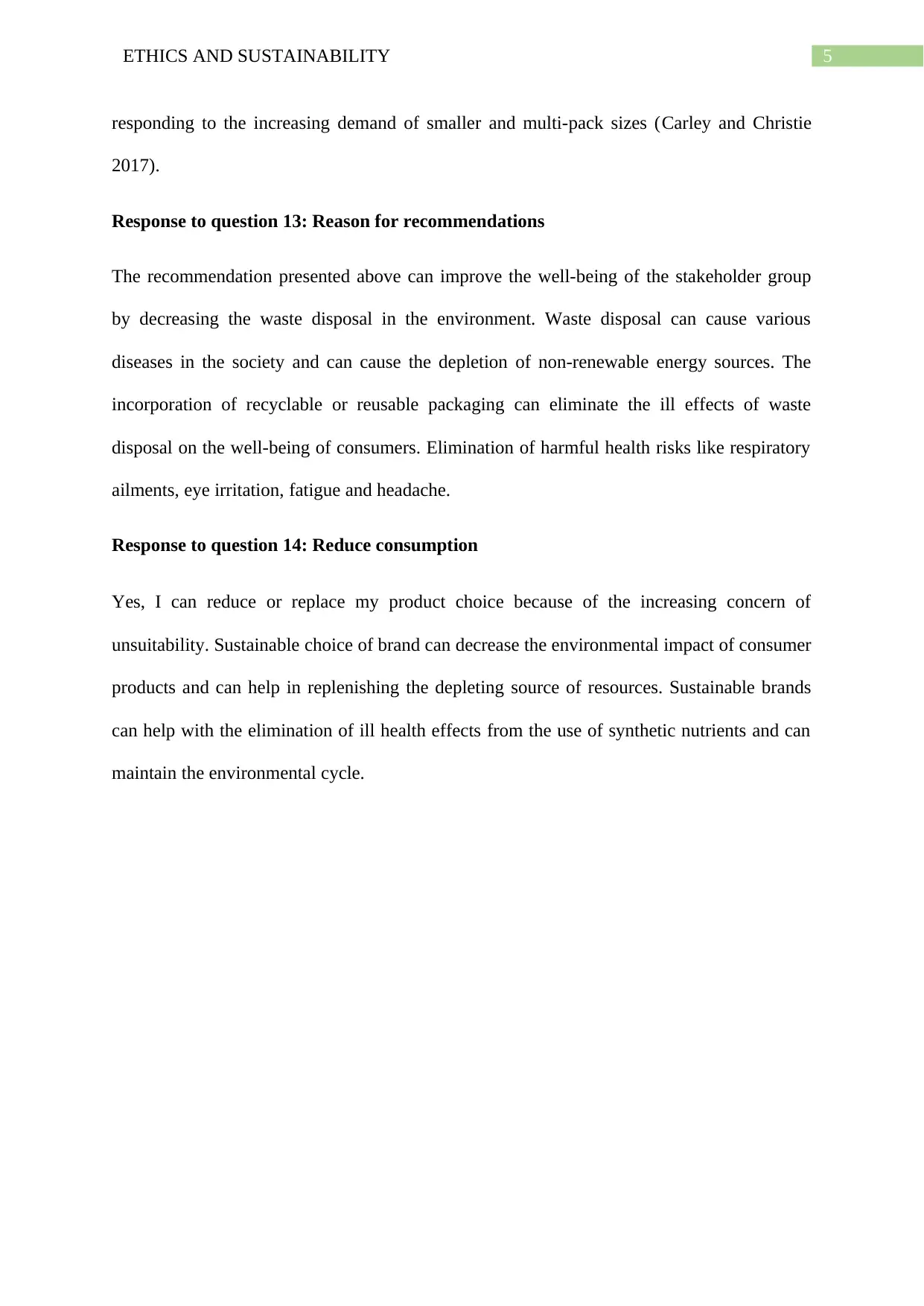
5ETHICS AND SUSTAINABILITY
responding to the increasing demand of smaller and multi-pack sizes (Carley and Christie
2017).
Response to question 13: Reason for recommendations
The recommendation presented above can improve the well-being of the stakeholder group
by decreasing the waste disposal in the environment. Waste disposal can cause various
diseases in the society and can cause the depletion of non-renewable energy sources. The
incorporation of recyclable or reusable packaging can eliminate the ill effects of waste
disposal on the well-being of consumers. Elimination of harmful health risks like respiratory
ailments, eye irritation, fatigue and headache.
Response to question 14: Reduce consumption
Yes, I can reduce or replace my product choice because of the increasing concern of
unsuitability. Sustainable choice of brand can decrease the environmental impact of consumer
products and can help in replenishing the depleting source of resources. Sustainable brands
can help with the elimination of ill health effects from the use of synthetic nutrients and can
maintain the environmental cycle.
responding to the increasing demand of smaller and multi-pack sizes (Carley and Christie
2017).
Response to question 13: Reason for recommendations
The recommendation presented above can improve the well-being of the stakeholder group
by decreasing the waste disposal in the environment. Waste disposal can cause various
diseases in the society and can cause the depletion of non-renewable energy sources. The
incorporation of recyclable or reusable packaging can eliminate the ill effects of waste
disposal on the well-being of consumers. Elimination of harmful health risks like respiratory
ailments, eye irritation, fatigue and headache.
Response to question 14: Reduce consumption
Yes, I can reduce or replace my product choice because of the increasing concern of
unsuitability. Sustainable choice of brand can decrease the environmental impact of consumer
products and can help in replenishing the depleting source of resources. Sustainable brands
can help with the elimination of ill health effects from the use of synthetic nutrients and can
maintain the environmental cycle.
⊘ This is a preview!⊘
Do you want full access?
Subscribe today to unlock all pages.

Trusted by 1+ million students worldwide
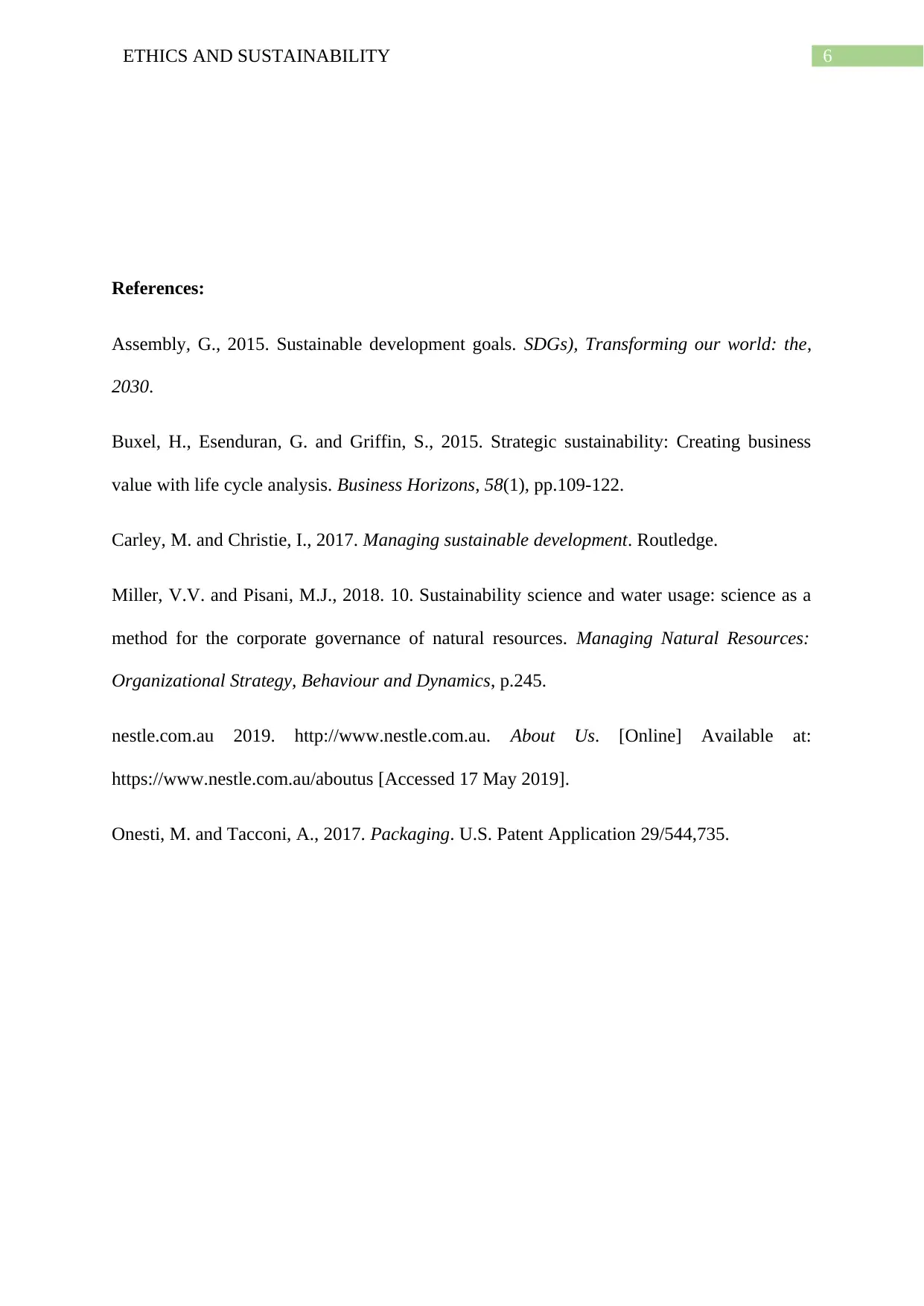
6ETHICS AND SUSTAINABILITY
References:
Assembly, G., 2015. Sustainable development goals. SDGs), Transforming our world: the,
2030.
Buxel, H., Esenduran, G. and Griffin, S., 2015. Strategic sustainability: Creating business
value with life cycle analysis. Business Horizons, 58(1), pp.109-122.
Carley, M. and Christie, I., 2017. Managing sustainable development. Routledge.
Miller, V.V. and Pisani, M.J., 2018. 10. Sustainability science and water usage: science as a
method for the corporate governance of natural resources. Managing Natural Resources:
Organizational Strategy, Behaviour and Dynamics, p.245.
nestle.com.au 2019. http://www.nestle.com.au. About Us. [Online] Available at:
https://www.nestle.com.au/aboutus [Accessed 17 May 2019].
Onesti, M. and Tacconi, A., 2017. Packaging. U.S. Patent Application 29/544,735.
References:
Assembly, G., 2015. Sustainable development goals. SDGs), Transforming our world: the,
2030.
Buxel, H., Esenduran, G. and Griffin, S., 2015. Strategic sustainability: Creating business
value with life cycle analysis. Business Horizons, 58(1), pp.109-122.
Carley, M. and Christie, I., 2017. Managing sustainable development. Routledge.
Miller, V.V. and Pisani, M.J., 2018. 10. Sustainability science and water usage: science as a
method for the corporate governance of natural resources. Managing Natural Resources:
Organizational Strategy, Behaviour and Dynamics, p.245.
nestle.com.au 2019. http://www.nestle.com.au. About Us. [Online] Available at:
https://www.nestle.com.au/aboutus [Accessed 17 May 2019].
Onesti, M. and Tacconi, A., 2017. Packaging. U.S. Patent Application 29/544,735.
1 out of 7
Your All-in-One AI-Powered Toolkit for Academic Success.
+13062052269
info@desklib.com
Available 24*7 on WhatsApp / Email
![[object Object]](/_next/static/media/star-bottom.7253800d.svg)
Unlock your academic potential
Copyright © 2020–2025 A2Z Services. All Rights Reserved. Developed and managed by ZUCOL.

